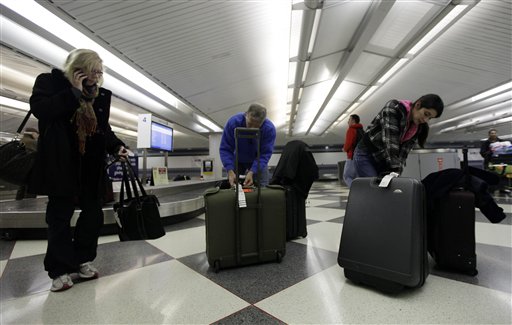WASHINGTON — Airlines are slowly, steadily recovering from their meltdown five years ago, when, under the strain of near-record consumer travel demand, their performance tanked.
Industry performance for all four measurements was slightly better in 2011 compared with 2010, according to the report being released today.
For airline passengers grappling with fare increases, canceled routes and a seemingly endless parade of new fees, “better” may not be the first word that comes to mind. But based on more traditional yardsticks — lost bags, delayed flights, lousy service and bumpings from full planes — airlines are doing a better job, say private researchers who have analyzed federal data on airline performance.
“Airlines are finally catching up with what their promise is, which is getting you there on time 80 percent of the time with your bags,” said Dean Headley, a business professor at Wichita State University who has co-written the annual report for 22 years.
“They realize that people are paying a lot more money, and the system is more complex than it was, and they have to do a better job,” he said. “To their credit, I think they are doing a better job.”
With higher fuel costs, airfares are trending up, although increases vary significantly depending on whether the passenger is flying between major airports, or is heading to or from a small or medium-sized airport, Headley said. As airlines cut back service to smaller airports, the cost of air travel in small and medium cities is increasing, he said.
“It really depends on the market you are in,” Headley said, noting that in 2010 he paid $275 to fly round-trip from Wichita, Kan., to Washington, where he released that year’s report. This year, the same trip cost him $360.
In judging quality of performance, low-cost carriers that mainly fly between large hubs tend to fare the best, Headley said. The large airlines that have been around since before airline deregulation in the early 1980s tend to fall in the middle. Regional airlines, which often fly smaller planes that have more difficulty avoiding storms, generally pull up the rear.
Airline performance last year was likely helped by a mild winter in much of the country despite an “October surprise” snowstorm that snarled the Northeast, he said.
Hawaiian Airlines did the best job of arriving on time with an average of 92.8 percent, while JetBlue Airways had the worst on-time performance, 73.3 percent. A flight is considered on time if it arrives within 15 minutes of when it was originally due.
Nearly half the 15 airlines improved their on-time arrival performance in 2011, and seven had an on-time arrival percentage over 80 percent — Hawaiian, Southwest Airlines, AirTran Airways, Alaska Airlines, American Airlines, Delta Air Lines, and Mesa Airlines. The average on-time performance for the industry was 80 percent last year, just a tad better than 2010’s average of 79.8 percent.
Mesa had the highest rate of passengers with tickets who were denied boarding, at 2.27 per 10,000 passengers. Such “bumpings” are usually due to overbooking. JetBlue had the lowest rate of bumped passengers, .01 per 10,000 passengers.
Ten airlines improved their denied boardings rate in 2011.
American Eagle, which is owned American’s parent company, AMR Corp. of Fort Worth, Texas, recorded the largest improvement, and Atlantic Southeast Airlines had the largest decline. Jet Blue, with its near zero rate, and Hawaiian, with a rate of 0.11 per 10,000 passengers, were clearly the industry leaders in avoiding bumping incidents. Industry performance was better in 2011 with an average bumping rate of .78 per 10,000 passengers compared with 1.08 the year before.
AirTran had the best baggage handling rate, 1.63 mishandled bags per 1,000 passengers. American Eagle had the worst baggage handling rate, 7.32 mishandled bags per 1,000 passengers. That was more than double the industry rate of 3.35.
Seven airlines improved mishandled baggage rates in 2011: Alaska, American, Atlantic Southeast, Delta, Frontier Airlines, JetBlue and SkyWest Airlines. The mishandled baggage rate for the industry decreased from 3.49 per 1,000 passengers in 2010 to 3.35 last year.
Southwest Airlines once again had the lowest consumer complaint rate, 0.32 complaints per 100,000 passengers; United Airlines had the highest consumer complaint rate at 2.21.
Headley attributed United’s high complaint rate to rough patches in the airline’s merger with Continental. The airlines, which merged their reservation operations in March, now operate under the United name.
The overall rate of customer complaints was virtually unchanged, 1.19 in 2011 compared to 1.22 in 2010. Only five of 15 airlines improved their customer complaint rates for 2011 — AirTran, Delta, Frontier, Hawaiian and JetBlue.
The majority of complaints fell into four categories: flight problems, 34.9 percent; baggage, 14.3 percent; customer service, 12.1 percent, and reservations, ticketing and boarding, 11.2 percent.
The ratings are based on data submitted to the Transportation Department by the 15 airlines who carried the most passengers domestically last year — AirTran, Alaska, American, American Eagle, Atlantic Southeast, Continental, Delta, Frontier, Hawaiian, JetBlue, Mesa, SkyWest, Southwest, United and US Airways. Headley and Purdue University aviation technology professor Brent Bowen, co-writer of the report, are scheduled to release an overall ranking of performance today. Their research is sponsored by Purdue, in Indiana, and Wichita State.
Send questions/comments to the editors.



Success. Please wait for the page to reload. If the page does not reload within 5 seconds, please refresh the page.
Enter your email and password to access comments.
Hi, to comment on stories you must . This profile is in addition to your subscription and website login.
Already have a commenting profile? .
Invalid username/password.
Please check your email to confirm and complete your registration.
Only subscribers are eligible to post comments. Please subscribe or login first for digital access. Here’s why.
Use the form below to reset your password. When you've submitted your account email, we will send an email with a reset code.